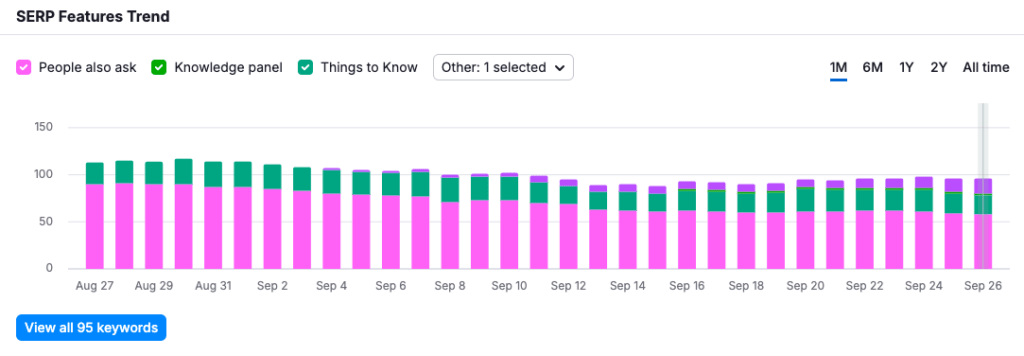Content decay is an unavoidable challenge for businesses and websites that rely on digital marketing to generate traffic and leads. The term “decaying content” describes the gradual decline in the performance of previously high-ranking content over time.
Search engines like Google continuously update their algorithms to prioritize the most relevant, up-to-date content, which often causes older pieces to lose their ranking position. Moreover, user behavior evolves, and topics that once attracted a lot of traffic may not be as appealing today.
In this comprehensive guide, we’ll explain what content decay is, why it happens, and, most importantly, how to identify and refresh your outdated or underperforming content to boost traffic, engagement, and search engine rankings.
What is Content Decay?
Content decay occurs when a piece of content gradually becomes less relevant, leading to a decrease in traffic and search engine rankings. This happens for various reasons:
- Search engine algorithm changes: Google and other search engines regularly update their search engine algorithms to prioritize the best content for users. These algorithms assess new content over time to determine its relevance and ranking potential, favoring fresher and more authoritative content, which often replaces older pages.
- Outdated information: If the data, statistics, or trends in a blog post or article are outdated, it won’t be seen as valuable to readers or search engines.
- Shifting user intent: The way people search for information can change over time. Search intent may evolve, making content less relevant.
- Increased competition: New competitors may publish more comprehensive or updated content on the same topic, pushing your content down in rankings.

The Importance of Content Decay for Marketers
For marketers, understanding this content decay is crucial as it directly impacts their SEO and marketing strategies. When content that once drove significant traffic starts to lose its effectiveness, it can lead to a noticeable drop in organic traffic and search rankings.
Recognizing the signs of content decay allows marketers to take proactive steps to refresh and update their content, ensuring it remains relevant and valuable to their target audience. By addressing content decay, marketers can maintain their content’s performance, keep their audience engaged, and sustain their competitive edge in search engine results pages.
Stages of the Content Life Cycle
The content life cycle consists of several stages, each playing a critical role in the performance and longevity of your content.
- Creation: This is the initial stage where content is published and indexed by search engines. At this point, the content is new and has the potential to attract organic traffic.
- Growth: During the growth stage, the content starts to gain traction. It sees an increase in organic traffic and begins to climb in search rankings as it attracts more visitors and engagement.
- Peak: The peak stage is where the content reaches its maximum potential. It enjoys high search rankings and significant organic traffic, often becoming a key asset in your content strategy.
- Decay: Eventually, content enters the decay stage, where it starts to lose relevance. This decline can be due to various factors such as outdated information, increased competition, or changes in search intent. As a result, the content experiences a drop in search rankings and organic traffic.
Understanding these stages helps marketers plan and execute strategies to extend the life of their content and maximize its performance.

Why Is It Important to Address Content Decay?
Addressing content decay is crucial for maintaining long-term search engine optimization (SEO) success and monitoring your content’s performance. When content performance declines, it leads to lower organic traffic, which can significantly affect lead generation, conversions, and revenue. By proactively managing content decay, you can ensure that your website remains competitive and relevant in the search engine results pages (SERPs).
Causes of Content Decay
Content decay can be attributed to several factors, each contributing to the gradual decline in a content’s performance. These include content age and freshness, internal and external competition, and changes in search intent and algorithm updates.
Content Age and Freshness
Search engines prioritize fresh and up-to-date content, which means that older content may be considered less relevant and valuable. As content ages, it may become outdated, and its relevance may decrease, leading to a decline in search rankings and organic traffic. Keeping content updated with the latest information, trends, and data is essential to maintaining its value and performance in search results.
Internal and External Competition
Internal competition occurs when multiple pieces of content on the same website compete for the same keywords and search rankings. This can lead to keyword cannibalization, where your own content competes against itself, diluting its effectiveness. External competition, on the other hand, occurs when other websites and content creators target the same keywords and search rankings.
Both types of competition can lead to content decay, as search engines may favor more relevant and valuable content from competitors. Regularly auditing your content and ensuring each piece has a unique focus can help mitigate internal competition, while staying updated on industry trends can help you stay ahead of external competitors.
Changes in Search Intent and Algorithm Updates
Changes in search intent and algorithm updates can also contribute to content decay. As search intent evolves, content that was once relevant may no longer be valuable. For example, if users start searching for different aspects of a topic, your content may no longer meet their needs.
Algorithm updates can also impact content’s performance, as search engines continually refine their ranking factors and algorithms. Staying informed about these changes and adapting your content accordingly can help maintain its relevance and performance.

How to Identify Content Decay
Before you can address content decay, you need to identify which pages on your website are underperforming. Here are actionable steps to help you do this:
Maintaining only relevant and high-quality content is essential for accurate evaluation of SEO metrics, as obsolete content can negatively impact metrics like organic traffic and average position. Utilizing SEO performance data can help improve overall site metrics by removing low-performing and outdated content.
1. Use Google Analytics and Search Console
Google Analytics and Google Search Console are essential tools for identifying pages with decreasing search traffic and rankings.
- Google Analytics: Navigate to the “Behavior” section and then select “Site Content” to view the performance of individual pages over time. Look for pages that have experienced a steady decline in traffic.
- Google Search Console: This tool provides more insights into keyword rankings. Check your “Performance” reports to find pages that have dropped in keyword rankings or impressions.
2. Track Content Performance Over Time
Monitor the performance of key content assets over time using tools like Ahrefs, Semrush, or Moz. These platforms offer detailed reports on content rankings and traffic patterns. Look for:
- Decline in keyword rankings: Check if your content is no longer ranking for its target keywords or if new competitors have taken the top spots.
- Drop in organic traffic: Identify pages that used to perform well but now see fewer visitors.
- Engagement metrics: Analyze engagement data such as bounce rates, time on page, and conversion rates. Pages with low engagement may indicate irrelevant or outdated content.

3. Set Up Content Decay Alerts
Some SEO tools, like Ahrefs, offer content decay alerts that notify you when a particular page loses its ranking or experiences a traffic drop. These alerts can help you stay proactive in identifying decayed content before it negatively impacts your overall SEO efforts.
4. Conduct Regular Content Audits
A regular content audit of your existing content is essential for identifying outdated and underperforming material. Aim to perform an audit at least every six months. During the audit, evaluate your content based on the following criteria:
- Relevance: Is the information still accurate? Has anything changed in the industry that makes the content less relevant?
- Search rankings: Check where the content ranks for its target keywords and whether there’s been a significant decline in position.
- Engagement: Is the content still engaging readers? Look at metrics such as click-through rates (CTR) and average time spent on the page.
How to Refresh and Revitalize Decayed Content
Once you’ve identified the content that is underperforming, the next step is to refresh it with up-to-date information and optimize it for better search rankings. Here’s a step-by-step guide on how to do that:
1. Update Outdated Information
The first step in refreshing content is to ensure all data, statistics, and information are up to date.
- Replace outdated statistics: Search for the latest statistics and replace the old ones in your article. For example, if a post from 2019 references market data, find 2024 statistics to make it current.
- Remove or update broken links: Broken links can negatively impact SEO and user experience. Use a tool like Screaming Frog to find broken links and replace them with updated resources.
- Refresh old examples: If your content includes examples or case studies, make sure they are still relevant. Replace outdated examples with more recent and impactful ones. This is especially important for blog posts, as they can rank for multiple keywords and need to stay current to avoid content decay and internal competition among blog posts on your website.
2. Add New Sections and Subtopics
If the content feels thin or doesn’t fully answer user intent, consider adding new sections, subheadings, or information that complements the original topic. This can include:
- New subtopics: If there are developments in your industry or changes in user search intent, incorporate them into your content.
- Answer new search queries: Use tools like AnswerThePublic or Semrush’s Keyword Magic Tool to discover questions and search queries that are relevant to your topic but weren’t covered in the original article.
3. Improve On-Page SEO
Optimizing your content for better on-page SEO can help it regain rankings. Focus on the following aspects:
- Title tags and meta descriptions: Revamp your title tag and meta description to be more compelling, include updated keywords, and reflect any new content added.
- Headers (H1, H2, H3): Ensure that your headers are properly structured and include relevant keywords. Break up long sections with clear subheadings to make the content easier to read.
- Internal linking: Add internal links to other relevant pages on your site to improve SEO and user navigation. Link from other high-performing pages to help boost the ranking of the updated content.
- Keyword optimization: Revisit your target keywords and include variations of them in your content. If there are new keywords related to your topic, integrate them naturally into the text.
4. Enhance the User Experience (UX)
The experience your readers have on your site can greatly impact content performance. If your page is difficult to navigate or doesn’t load quickly, users may leave before they’ve engaged with the content. Improve UX by:
- Improving page speed: A slow-loading page can cause users to bounce, which negatively impacts rankings. Use Google PageSpeed Insights to analyze your page’s speed and make adjustments such as optimizing images and reducing code bloat.
- Optimizing for mobile: With more users browsing from mobile devices, it’s crucial that your content is fully responsive and easy to read on smaller screens.
- Breaking up content: Ensure the content is broken into digestible sections with plenty of white space. Use bullet points, numbered lists, and short paragraphs to improve readability.

5. Add Visual Elements
People engage better with content that includes visuals. Consider adding:
- Images and infographics: Use original images, infographics, or charts to make your content more engaging and informative. This also increases the likelihood of your content being shared on social media.
- Videos: Embedding videos that explain complex concepts or provide additional information can improve user engagement. Google increasingly favors video content, so this can also help with SEO.
- Interactive elements: If possible, add interactive elements like polls, quizzes, or embedded calculators. These features can boost engagement and time on page, which are important ranking factors.
6. Strengthen E-E-A-T (Experience, Expertise, Authoritativeness, and Trustworthiness)
Google places significant importance on a website’s E-E-A-T (Experience, Expertise, Authoritativeness, and Trustworthiness). Improving your content’s E-E-A-T can help it rank higher and attract more traffic.
- Add expert quotes: Include quotes or references from industry experts to increase the authority of your content.
- Cite credible sources: Ensure that all claims are backed up by credible sources. Link to reputable studies, white papers, and government websites to enhance trustworthiness.
- Author bio updates: If your content has an author, update their bio to highlight their expertise on the topic. This can improve the content’s perceived authority.
7. Promote Your Refreshed Content
Once you’ve updated and optimized your content, you’ll need to re-promote it to drive new traffic.
- Share on social media: Share the updated article across your social media platforms, mentioning any new sections or updates.
- Email newsletter: Include the refreshed content in your email newsletter and let subscribers know that the article has been updated with new insights or information.
- Internal promotion: Link to the refreshed content from other relevant pages on your website to give it additional exposure.
Tools for Managing Content Decay
Several tools can help you manage and monitor content decay effectively:
- Ahrefs: Track keyword rankings, identify decayed content, and find opportunities for optimization with Ahrefs’ content explorer and site audit tools.
- Semrush: This tool provides valuable data on organic traffic, keyword rankings, and content performance. You can set up alerts to monitor content decay.
- Google Search Console: Use Google Search Console to monitor search rankings, impressions, and click-through rates. It’s a great tool for spotting content decay early.
- Screaming Frog: This tool helps you identify broken links and other technical SEO issues that may be contributing to content decay.
Search engine algorithms assess new content over time to determine its relevance and ranking potential, favoring fresh content that aligns with current keyword intent.
A Long-Term Strategy for Combating Content Decay
To prevent content decay from harming your website’s overall performance, it’s essential to develop a long-term strategy. This includes:
1. Scheduling Regular Content Updates
Make a plan to review and update your content on a regular basis, such as every six to twelve months. This proactive approach will keep your content fresh, relevant, and optimized.
2. Building Evergreen Content
Focus on creating evergreen content that will remain relevant for a long time. While all content can decay, evergreen topics—such as how-to guides, foundational industry knowledge, or tutorials—have a longer shelf life.
3. Keeping an Eye on Competitors
Monitor what your competitors are doing. If they are consistently publishing more up-to-date content on the same topics, it may be time to refresh or expand your own articles.
4. Utilizing Content Re-Optimization Tools
There are several re-optimization tools that can help you maintain content performance over time. Tools like Clearscope or MarketMuse analyze your content against top-ranking pages and suggest ways to improve keyword coverage and relevance.
The Bottom Line
Content decay is a natural part of the digital content lifecycle, but it doesn’t have to result in permanent traffic loss. By regularly auditing your content, updating outdated information, optimizing for SEO, and enhancing the user experience, you can breathe new life into your old posts. With the right approach, you’ll not only restore traffic but also strengthen your site’s authority and search rankings in the long run.
Looking for professional Content Marketing and SEO services? Markitors is here to help. Contact us today!







